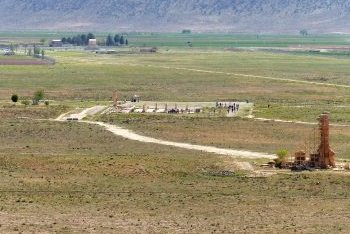
Before investigating this WHS in advance of our trip in Apr 2016, I had always assumed that it consisted solely of the Tomb of Cyrus – that famous “profile” consisting of a 6 stepped ziggurat topped by a rectangular gabled chamber (making it the World’s oldest “base isolated” structure according to Wiki). As such, it could surely be fitted in easily on a 1 day return outing from Shiraz together with Persepolis AND Naqsh-e Rustam? In fact the site extends to 160ha (the inscribed area of Perspolis is only 13ha) and we spent 2 hrs there, not getting back to Shiraz until 19.30 (having departed at 8.20). If you are going to do a similar day trip make sure you leave some time for Pasargadae - unless you only want a quick “turn” around the Tomb!
As you draw up to the ticket office (Entry for foreigners - 200k rials) the entry sign is accompanied by an enormous propaganda notice board proclaiming, first in English and then in Farsi, the words of Khomeini “The whole World should know that all of the problems of the Iranian nation and other nations are caused by the foreigners: by America. The Muslim nations hate the foreigners in general and America in particular”. Even our driver/guide was a little embarrassed by this since it seemed so out-of-line both with the welcome we (as “foreigners”!!) had received from every Iranian we had met and also with the general direction of Iran’s international relations. I have traced the statement’s history to a speech made by Khomeini at Qom on Oct 26th 1964 – not exactly “recent history”! It must have been the “last straw” for the Shah, as Khomeini was exiled to Turkey on Nov 4th and would spend the next 14 years outside Iran. Now, this quotation is apparently very “famous” in the history of events leading up to the Iranian Revolution (The full speech and its background can be found here), but the interesting question about its location in 2016 outside the World Heritage Site of Pasargadae relates to the nature of “power” in contemporary Iran which has led to its being published and remaining there. Who/which organisation has thought that this propaganda sign outside a World Heritage Site is “appropriate” and has been able to hold out against others who must surely think it is not?
The Tomb of Cyrus is situated close to the entrance and seeing it isn’t going to take very long. You may gain value from walking around it a few times and, perhaps, imagining the visit of Alexander the Great in 330BC when, according to legend, he paid homage to Cyrus. You may also need to wait a bit to take a photo without hordes of tourists in it! You can’t actually approach the steps.
Beyond, lie the remains of what was originally the dynastic capital of the Achaemenids. Its furthest point, the fortified terrace of Tel-e Takht, is around 2.5 kms away so, if you have a car, you might as well drive there and work your way back. In all honesty there isn’t a great deal “on display”. The Tel is made up of enormous cyclopean stones but has little else of interest. I provide a photo from its summit, not because it is a “good” photo, but to give an indication of the overall site and the dry plain on which it is set – the Tomb of Cyrus can be seen at top left. The Palace area is mid-centre with the “Garden” to its left. This area continues left outside the photo, is only accessible on foot and takes a while to cover. The tower on the right is the so-called "Soleyman's Prison".
The area of greatest interest to us was that containing the Pasargadae element of the Persian Gardens’ inscription. This is a part of the “The Royal Ensemble” containing basically the floor plans of several palaces and pavilions plus a few pillars with some carvings – and the Garden. The site plan indicated that we were indeed “in” it - but it was very difficult to see anything which looked as if it could have been a part of a “garden”. There are a few stones which are said to be part of a bridge which crossed the river which, in those days, flowed through the city - but now all is dryness. Eventually we found a possible “corner” of such a garden created by 2 lines of carved stones which could have held a flowing stream as per the more modern “Persian Gardens” we were visiting around Iran. Don’t expect too much of this one!
And that was about it really. One couldn’t recommend going out of one’s way to see the remains of the palaces etc but “that tomb” just about redeems it.
More on
Comments
No comments yet.
